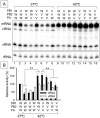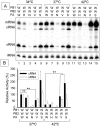Artificial hybrids of influenza A virus RNA polymerase reveal PA subunit modulates its thermal sensitivity
- PMID: 21151876
- PMCID: PMC2998429
- DOI: 10.1371/journal.pone.0015140
Artificial hybrids of influenza A virus RNA polymerase reveal PA subunit modulates its thermal sensitivity
Abstract
Background: Influenza A virus can infect a variety of different hosts and therefore has to adapt to different host temperatures for its efficient viral replication. Influenza virus codes for an RNA polymerase of 3 subunits: PB1, PB2 and PA. It is well known that the PB2 subunit is involved in temperature sensitivity, such as cold adaptation. On the other hand the role of the PA subunit in thermal sensitivity is still poorly understood.
Methodology/principal findings: To test which polymerase subunit(s) were involved in thermal stress we reconstituted artificial hybrids of influenza RNA polymerase in ribonucleoprotein (RNP) complexes and measured steady-state levels of mRNA, cRNA and vRNA at different temperatures. The PA subunit was involved in modulating RNP activity under thermal stress. Residue 114 of the PA subunit was an important determinant of this activity.
Conclusions/significance: These findings suggested that influenza A virus may acquire an RNA polymerase adapted to different body temperatures of the host by reassortment of the RNA polymerase genes.
Conflict of interest statement
Figures






Similar articles
-
Replication and transcription activities of ribonucleoprotein complexes reconstituted from avian H5N1, H1N1pdm09 and H3N2 influenza A viruses.PLoS One. 2013 Jun 4;8(6):e65038. doi: 10.1371/journal.pone.0065038. Print 2013. PLoS One. 2013. PMID: 23750226 Free PMC article.
-
The RNA polymerase PB2 subunit of influenza A/HongKong/156/1997 (H5N1) restricts the replication of reassortant ribonucleoprotein complexes [corrected].PLoS One. 2012;7(2):e32634. doi: 10.1371/journal.pone.0032634. Epub 2012 Feb 28. PLoS One. 2012. PMID: 22389716 Free PMC article.
-
Differential role of the influenza A virus polymerase PA subunit for vRNA and cRNA promoter binding.Virology. 2008 Jan 5;370(1):194-204. doi: 10.1016/j.virol.2007.08.029. Epub 2007 Oct 1. Virology. 2008. PMID: 17905403
-
The RNA polymerase of influenza a virus: mechanisms of viral transcription and replication.Acta Virol. 2013;57(2):113-22. doi: 10.4149/av_2013_02_113. Acta Virol. 2013. PMID: 23600869 Review.
-
The molecular anatomy of influenza virus RNA polymerase.Biol Chem. 1997 Jun;378(6):483-8. Biol Chem. 1997. PMID: 9224927 Review.
Cited by
-
The temperature-sensitive and attenuation phenotypes conferred by mutations in the influenza virus PB2, PB1, and NP genes are influenced by the species of origin of the PB2 gene in reassortant viruses derived from influenza A/California/07/2009 and A/WSN/33 viruses.J Virol. 2014 Nov;88(21):12339-47. doi: 10.1128/JVI.02142-14. Epub 2014 Aug 13. J Virol. 2014. PMID: 25122786 Free PMC article.
-
The new temperature-sensitive mutation PA-F35S for developing recombinant avian live attenuated H5N1 influenza vaccine.Virol J. 2012 May 23;9:97. doi: 10.1186/1743-422X-9-97. Virol J. 2012. PMID: 22621130 Free PMC article.
-
The N-terminal fragment of a PB2 subunit from the influenza A virus (A/Hong Kong/156/1997 H5N1) effectively inhibits RNP activity and viral replication.PLoS One. 2014 Dec 2;9(12):e114502. doi: 10.1371/journal.pone.0114502. eCollection 2014. PLoS One. 2014. PMID: 25460916 Free PMC article.
-
PA from an H5N1 highly pathogenic avian influenza virus activates viral transcription and replication and induces apoptosis and interferon expression at an early stage of infection.Virol J. 2012 Jun 8;9:106. doi: 10.1186/1743-422X-9-106. Virol J. 2012. PMID: 22681768 Free PMC article.
-
Effect of a fever in viral infections - the 'Goldilocks' phenomenon?World J Clin Cases. 2021 Jan 16;9(2):296-307. doi: 10.12998/wjcc.v9.i2.296. World J Clin Cases. 2021. PMID: 33521098 Free PMC article. Review.
References
-
- Centers for Disease Control and Prevention (CDC) Update: novel influenza A (H1N1) virus infections - worldwide, May 6, 2009. MMWR Morb Mortal Wkly Rep. 2009;58:453–458. - PubMed
-
- World Health Organization (WHO) Pandemic (H1N1) 2009. 2010. http://wwwwhoint/csr/disease/swineflu/en/indexhtml.
-
- Dawood FS, Jain S, Finelli L, Shaw MW, Lindstrom S, et al. Emergence of a novel swine-origin influenza A (H1N1) virus in humans. N Engl J Med. 2009;360:2605–2615. - PubMed
Publication types
MeSH terms
Substances
LinkOut - more resources
Full Text Sources
Other Literature Sources
Miscellaneous

